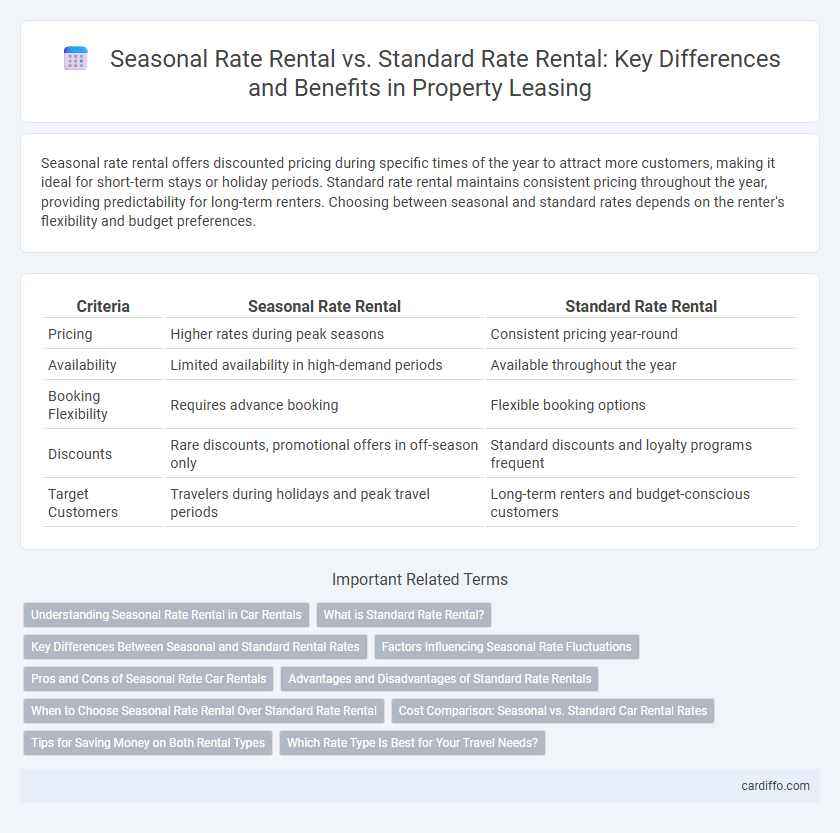Seasonal rate rental offers discounted pricing during specific times of the year to attract more customers, making it ideal for short-term stays or holiday periods. Standard rate rental maintains consistent pricing throughout the year, providing predictability for long-term renters. Choosing between seasonal and standard rates depends on the renter's flexibility and budget preferences.
Table of Comparison
| Criteria | Seasonal Rate Rental | Standard Rate Rental |
|---|---|---|
| Pricing | Higher rates during peak seasons | Consistent pricing year-round |
| Availability | Limited availability in high-demand periods | Available throughout the year |
| Booking Flexibility | Requires advance booking | Flexible booking options |
| Discounts | Rare discounts, promotional offers in off-season only | Standard discounts and loyalty programs frequent |
| Target Customers | Travelers during holidays and peak travel periods | Long-term renters and budget-conscious customers |
Understanding Seasonal Rate Rental in Car Rentals
Seasonal rate rental in car rentals refers to pricing adjustments based on fluctuating demand during specific times of the year, such as holidays or peak travel seasons. These rates are typically higher than standard rate rentals due to increased customer demand and limited vehicle availability. Understanding seasonal rate rental helps renters plan their budgets effectively and secure vehicles at competitive prices during high-demand periods.
What is Standard Rate Rental?
Standard rate rental refers to the consistent base pricing applied to rental properties throughout the year, excluding any seasonal fluctuations or special promotions. This rate is typically used as the default pricing benchmark for long-term lease agreements and regular rental periods. Property owners rely on the standard rate rental to ensure steady income and simplify pricing strategies outside peak or off-peak seasons.
Key Differences Between Seasonal and Standard Rental Rates
Seasonal rate rentals typically fluctuate based on high or low demand periods linked to specific seasons, resulting in increased prices during peak times such as holidays or summer months. Standard rate rentals maintain consistent pricing throughout the year, offering predictable costs regardless of seasonal changes. Understanding these differences helps renters and property managers optimize pricing strategies and budget planning according to rental market trends.
Factors Influencing Seasonal Rate Fluctuations
Seasonal rate rentals fluctuate based on factors such as demand shifts during peak holiday periods, local event schedules, and weather conditions that attract tourists. Property location and amenities also contribute to varying seasonality impacts, with coastal or ski resort rentals experiencing more significant rate changes. Understanding these influences helps landlords optimize pricing strategies to maximize revenue throughout the year.
Pros and Cons of Seasonal Rate Car Rentals
Seasonal rate car rentals offer lower prices during off-peak periods, making them ideal for budget-conscious travelers seeking cost savings. However, peak season demands can lead to limited vehicle availability and higher prices, reducing flexibility and potentially causing booking challenges. These rental rates often reflect market fluctuations, requiring customers to plan trips carefully to maximize benefits while avoiding unexpected price surges.
Advantages and Disadvantages of Standard Rate Rentals
Standard rate rentals provide consistent pricing that simplifies budgeting for tenants and ensures steady income for property owners throughout the year. However, this pricing model may result in lower occupancy during peak seasons when competitors offer discounted seasonal rates. Property owners might miss opportunities to maximize revenue during high-demand periods due to the inflexibility of standard rates.
When to Choose Seasonal Rate Rental Over Standard Rate Rental
Seasonal rate rentals offer cost savings during peak demand periods such as holidays, summer vacations, or special local events when prices typically rise due to increased occupancy rates. Choosing seasonal rate rentals is ideal for travelers with flexible dates aiming to maximize affordability while accessing high-demand destinations. Standard rate rentals are better suited for consistent budgeting and availability outside fluctuating seasonal peaks.
Cost Comparison: Seasonal vs. Standard Car Rental Rates
Seasonal rental rates typically surge during peak travel months, often increasing 20-50% compared to standard rates due to heightened demand. Standard rental rates offer more stable, lower prices driven by consistent availability outside high-demand seasons. Analyzing cost differences reveals substantial savings when booking standard rate rentals during off-peak periods.
Tips for Saving Money on Both Rental Types
Maximize savings on seasonal rate rentals by booking well in advance and targeting shoulder seasons when demand and prices are lower. For standard rate rentals, negotiate longer stays or off-peak days to unlock discounts and ensure better deals. Comparing both options using price tracking tools and flexible travel dates reveals the best balance between cost and availability.
Which Rate Type Is Best for Your Travel Needs?
Seasonal rate rentals offer lower prices during off-peak periods and higher costs during peak seasons, ideal for travelers with flexible dates seeking budget savings. Standard rate rentals maintain consistent pricing year-round, providing reliability and ease of planning for those with fixed travel schedules. Choosing between seasonal and standard rates depends on your travel flexibility and budget priorities to maximize value and convenience.
Seasonal Rate Rental vs Standard Rate Rental Infographic

 cardiffo.com
cardiffo.com